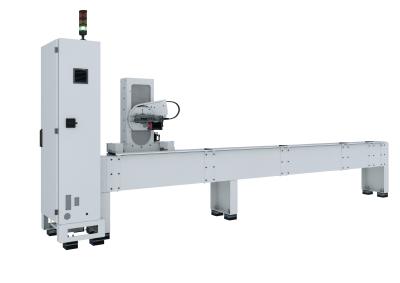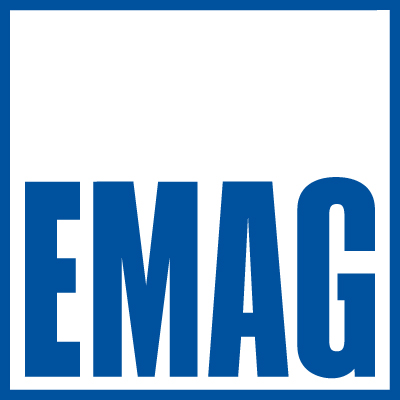
Only 20 years ago, the Internet became accessible to the general public. What started out with CDs glued to magazines and strange beeping modems has become one of the greatest technological revolutions since the invention of the steam engine. Networking and digitalization have changed almost every aspect of our daily lives – and now the Internet is about to revolutionize industry as well. Industry 4.0 is a relatively simple term; however, it contains complex challenges involving questions of unified standards, safety, and the value-added process. Industry 4.0 is networking, primarily between widely diverse fields of business and technologies that used to coexist independently and are now expected to enter into a symbiotic relationship to shape tomorrow’s production processes.
“It took 10 years to move from home Internet to the smartphone, and then another 10 years for ‘life online’ to become what it is today,” says Peter Loetzner, president and CEO of EMAG LLC. “Even though this revolution happened quickly, it still took two decades. I think we should expect a similar timescale when looking at Industry 4.0. There is going to be a lot to develop and testing before we take full advantage of Industry 4.0 the way we live our networked lives today,” Loetzner adds. “That’s why here at EMAG, we decided to take a very pragmatic approach to the Industry 4.0 concept: We design networked solutions based on products and technologies that are available today, while keeping an eye on current developments to adapt our products to the market. The main goal of this is to offer the market and our customers the kind of solutions that they want and need.”
By just looking at the machines in the Modular Solutions series, there is nothing that gives away that these are machine tools using a wide variety of technologies – except for the type designation. The machines themselves pretty much all look the same. “Of course that’s intentional, and it’s also part of the success of our Modular Solutions,” Loetzner explains. “The mechanical design is optimized to facilitate the interlinking of several machines. The gaps between machines, the transfer height, the placement of energy containers and chip conveyors – all that is standardized to enable the efficient construction of complex production lines based on a modular approach.“
At EMAG, Modular Solutions means a multiple-technology machine concept on a unified basic platform. All the machines in the EMAG Modular Solutions series have the same machine base made out of Mineralit polymer concrete, essentially a chassis on which the rest of the machine is installed. Every machine of this type also comes with EMAG’s signature pick-up automation system. This means that each machine has an integrated parts storage unit for blanks and finished parts. A pick-up spindle automatically loads and unloads the machine. For machining the workpieces, the EMAG Group’s entire range of technologies is available. For turning operations, the machines are equipped with powerful working spindles and EMAG’s proprietary turret with twelve tool posts. The latter can also be fitted with driven tools for drilling and milling. Gears are made using technologies from EMAG. To complement our hobbing processes, a variety of methods for chamfering and deburring are available, depending on the requirements of the part. For hard machining, inside and outside grinding are available as well as technologies and tools for hard turning and scroll-free turning.
“This diversity of technologies on a unified machine base, combined with EMAG’s proprietary TrackMotion automation system, is our idea of production systems for Industry 4.0,” Loetzner adds.
The TrackMotion automation system is the logical continuation of the concept behind Modular Solutions. Like the machines, the automation system is designed to be completely modular and can be adapted optimally to any production project. “To achieve the best symbiosis of automation and machine tool, we designed our machines so that the automation system can traverse directly behind the machining area. We basically built the machines with a tunnel for the TransLift to operate in. This really sets our Modular Solutions apart from the competition,” Loetzner explains.
The TransLift is an NC gripper that moves on a rail system through the tunnel mentioned above. The gripper transfers workpieces between the parts storage unit and then machines and flips the part over between operations. “The automation system is also easy to scale by simply extending the rail for additional TransLifts to run on. The system is simple but ingenious,” he adds. “One thing that makes the overall system so interesting for Industry 4.0 is its focus on the single part. Instead of keeping dozens of workpieces in various stages of completion somewhere on a conveyor between or behind the machines, separate transport makes each part trackable without requiring special marking.”
This intelligent part tracking concept is implemented entirely in the software. It enables optimal process tracking and quality assurance, and it provides a complete overview of the current status of production. “We are able to track every single part from start to finish. We’re able import previously recorded data into our system and export the data recorded on our machines during production. This makes us completely open with regard to the development of future interfaces,” Loetzner explains.
During production, parts quality is monitored continuously with measuring probes or other intelligent measuring systems. “We are experimenting with a range of different measuring systems in order to optimize results in terms of non-productive time and parts quality. All systems are integrated in the machines, and the readings are stored centrally. Combined with the integration into shopfloor systems, this enables us to take a holistic approach to quality assurance. Integrated removal stations make it easy to discharge rejects or pick samples for external measurement. To keep track, the software creates an entry when this happens,” Loetzner says. “As already said, we are completely open with regard to the data after the machining operation. Laser markings on the component, data transfer to workpiece carriers via NFC, or storage in cloud systems – any system that the customer wants to use can be integrated into our systems without any problems. Even today, we are offering our customers end-to-end management, documentation and processing of job, process, and machine data.”
With its Modular Solutions, EMAG is offering a production system today that is already prepared for the challenges of the future. “We break down complex production processes into simple process steps, which we then implement on individual machines. From a data point of view, this creates clearly defined data packets that can be attributed to individual machines, machining processes, and parts. From a production point of view, it means short process cycles per machine resulting in a short total cycle, which in turn improves the productivity of the system as a whole,” Loetzner says. ”Here at EMAG, we are confident that our concept is a match for any challenge that the market is going to set us in the future – with a product that you can already buy today.”
Contact Details
Related Glossary Terms
- chamfering
chamfering
Machining a bevel on a workpiece or tool; improves a tool’s entrance into the cut.
- gang cutting ( milling)
gang cutting ( milling)
Machining with several cutters mounted on a single arbor, generally for simultaneous cutting.
- grinding
grinding
Machining operation in which material is removed from the workpiece by a powered abrasive wheel, stone, belt, paste, sheet, compound, slurry, etc. Takes various forms: surface grinding (creates flat and/or squared surfaces); cylindrical grinding (for external cylindrical and tapered shapes, fillets, undercuts, etc.); centerless grinding; chamfering; thread and form grinding; tool and cutter grinding; offhand grinding; lapping and polishing (grinding with extremely fine grits to create ultrasmooth surfaces); honing; and disc grinding.
- hard turning
hard turning
Single-point cutting of a workpiece that has a hardness value higher than 45 HRC.
- milling
milling
Machining operation in which metal or other material is removed by applying power to a rotating cutter. In vertical milling, the cutting tool is mounted vertically on the spindle. In horizontal milling, the cutting tool is mounted horizontally, either directly on the spindle or on an arbor. Horizontal milling is further broken down into conventional milling, where the cutter rotates opposite the direction of feed, or “up” into the workpiece; and climb milling, where the cutter rotates in the direction of feed, or “down” into the workpiece. Milling operations include plane or surface milling, endmilling, facemilling, angle milling, form milling and profiling.
- numerical control ( NC)
numerical control ( NC)
Any controlled equipment that allows an operator to program its movement by entering a series of coded numbers and symbols. See CNC, computer numerical control; DNC, direct numerical control.
- quality assurance ( quality control)
quality assurance ( quality control)
Terms denoting a formal program for monitoring product quality. The denotations are the same, but QC typically connotes a more traditional postmachining inspection system, while QA implies a more comprehensive approach, with emphasis on “total quality,” broad quality principles, statistical process control and other statistical methods.
- turning
turning
Workpiece is held in a chuck, mounted on a face plate or secured between centers and rotated while a cutting tool, normally a single-point tool, is fed into it along its periphery or across its end or face. Takes the form of straight turning (cutting along the periphery of the workpiece); taper turning (creating a taper); step turning (turning different-size diameters on the same work); chamfering (beveling an edge or shoulder); facing (cutting on an end); turning threads (usually external but can be internal); roughing (high-volume metal removal); and finishing (final light cuts). Performed on lathes, turning centers, chucking machines, automatic screw machines and similar machines.

